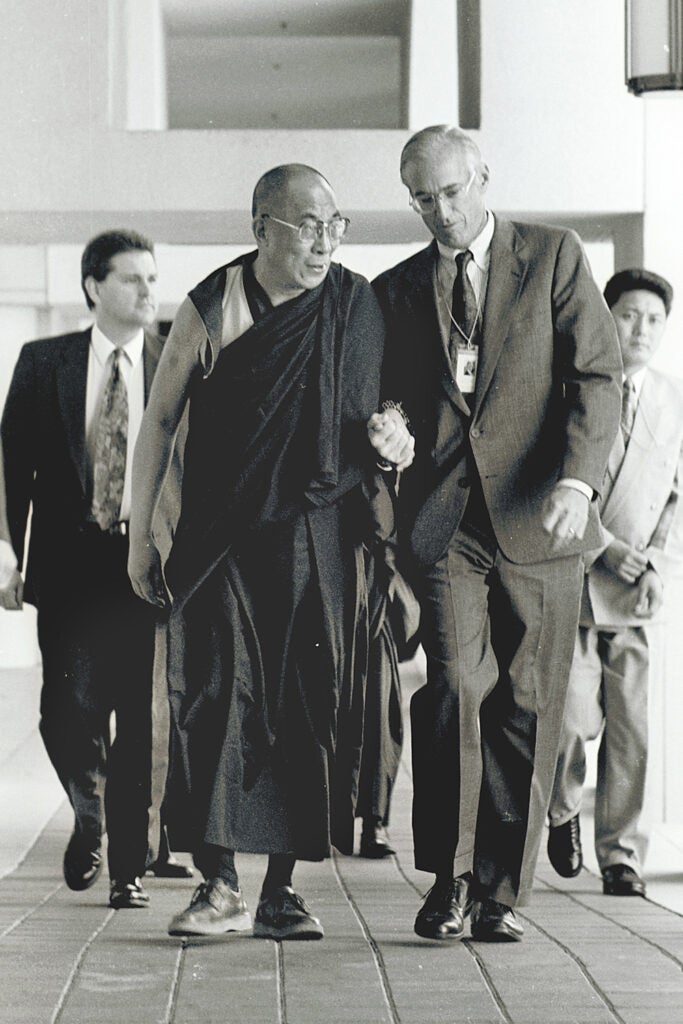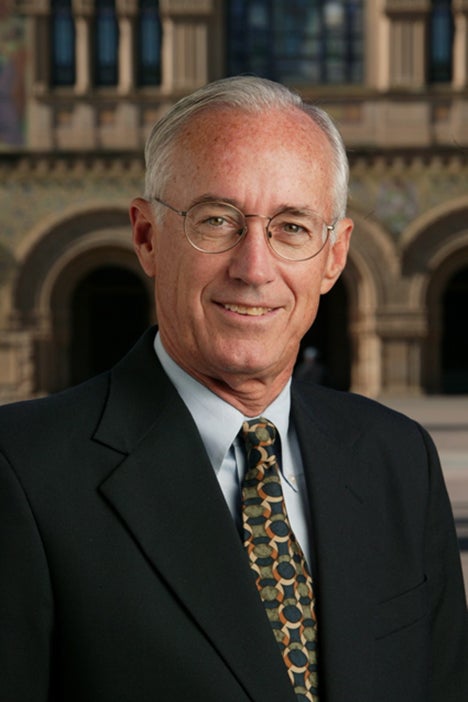Robert C. Gregg, former professor and dean who catalyzed a multifaith approach to religious life on campus, has died
Scholarly, approachable, and direct, Robert Gregg created new opportunities for worship and the exploration of questions about faith while serving as a professor and dean for religious life at Stanford.
Robert C. Gregg, a scholar of early Christianity who welcomed many faith traditions and whose vision as dean for religious life at Stanford continues to have an impact decades later, died from a stroke March 20 in Palo Alto. He was 84.
Gregg came to Stanford in 1987 and served as dean for religious life until 1999 when he resumed full-time teaching and research as the Teresa Hihn Moore Professor in Religious Studies in the School of Humanities and Sciences. He retired as a professor in 2005.
During his tenure at Stanford, he was frequently at the heart of efforts to adapt religious life on campus to a more diverse population.
He hired the first non-Christian associate deans in the religious life office, expanded Baccalaureate from a largely Christian-focused service to a celebration that reflected the many faith traditions found on campus, and developed courses that enabled students to delve more deeply into various faith practices and histories. He created and served as founding director of the Abbasi Program for Islamic Studies.
These reflected a growing recognition of and appreciation for a campus community that had begun to change over the years.
Serving a diverse community of many and no faiths
Gregg summed up the changed environment in Soul Man on Campus, a STANFORD magazine Q&A, in 1993.
“What we have at Stanford,” he observed, “is a community whose diversity also extends into religious groupings which are multifaith, decidedly multifaith – with a significant block of people who are of no faith, no explicit faith connection at all.”
Friends and associates remember Gregg as someone whose intellect and charm helped him navigate administrative complexities and resist pushback.
Rabbi Patricia Karlin-Neumann, hired by Gregg as the first non-Christian associate dean in 1996, was an early example of the transitions he drove. She described Gregg’s approach to his work as scholarly and thoughtful, affable but direct.
“He was very careful and scrupulous and critical, in the best sense, but he never stood on ceremony. He never took himself too seriously and never let anybody else take themselves too seriously, which gave him an in into all kinds of situations that might have been really tense otherwise,” Karlin-Neumann said. She recalled how his “clear blue-grey eyes were often gentle and laughing, but could be piercing when someone was inauthentic.”
Growing through education and action
Gregg was born in 1938 and grew up in Houston. He earned a bachelor’s degree in English literature at the University of the South in Tennessee in 1960, where he protested disciplinary action taken against professors who met with area Black leaders for discussions critical of racial segregation.
Back home in Houston during a break in 1960, he met Mary Layne Shine, who was visiting from Illinois. They were married in 1961. Years later, when interviewed for a Stanford Historical Society oral history, he said, “… she and our relationship, and my privilege of being married to her, is the single most important thing in my life.”
Gregg received a master’s from Episcopal Divinity School in Cambridge, Massachusetts, in 1963 and was ordained as an Episcopal priest in 1964, after which he traveled to Mississippi to participate in voter registration efforts during Freedom Sumer. After beginning doctoral studies at Brown University, he transferred to the University of Pennsylvania, where he earned a PhD in religious thought.
He served as chaplain and taught religion and philosophy at St. George’s School in Rhode Island, before becoming assistant professor of New Testament language and literature at Seabury-Western Theological Seminary in Illinois. He subsequently moved to Duke University, where his teaching and research focused on the early Christian church and the social history of religions.
Knocking down barriers and building community
In 1987, the Greggs moved to Stanford, where he would become known, in the words of former university President Richard W. Lyman, as “spiritual leader, all-purpose counselor, mediator, peacemaker and comforter of the afflicted.”

His Holiness the Dalai Lama is greeted by Dean of Religious Life Robert Gregg on April 19, 1994. (Image credit: L.A. Cicero)
Dean for Religious & Spiritual Life Tiffany L. Steinwert came to know her predecessor as a mentor, sounding board, and friend.
“We, in the Office for Religious & Spiritual Life, stand on the shoulders of Dean Gregg. Without his vision, tenacity, and deep appreciation and admiration for the plurality of faith, the office as it exists today, in all its multifaith expressions, would simply not be possible,” Steinwert said. “Dean Gregg was among the first deans in the country to recognize and respond to the growing spiritual needs of campuses. He understood that religious life must be inherently diverse, making space for those across many religious traditions and none at all.”
Gregg revised his title from dean of Memorial Church to dean for religious life (later expanded by Steinwert to include “spiritual life”). In addition to Rabbi Karlin-Neumman, he hired the first Muslim and Black associate deans in his office. He also invited the Dalai Lama to his first visit to Stanford, in 1994.
Colleagues recall him knocking down walls, literally, to create prayer and worship space for an array of non-Christian believers in Old Union. Not only did he spearhead reconstruction of Memorial Church after the 1989 Loma Prieta earthquake, working closely with university Trustee Melvin Lane to raise funds and complete extensive repairs quickly, but he also opened MemChu to same-sex commitment ceremonies.
Blending scholarship with an ‘openness to otherness’
In addition to his administrative duties, he continued his teaching and research through appointments to the Classics and Religious Studies departments, and received the Richard W. Lyman Award for Faculty Volunteer Service in 1996. He authored five books, including influential studies on the competition of religions in the late Roman-early medieval Mediterranean and Levant, and edited a sixth.
Over time, his focus expanded to address questions he heard around campus.
As invitations to attend dorm dinners became frequent, he developed an informal presentation titled “Where are Your Religious Edges?” Those discussions and others around campus led him to create the class I Am Spiritual Not Religious. What Does This Mean? that examined the interplay of religious institutions, morals, and values, and of individualism and communal existence.
Three Sacred Stories, another class he created, helped students look at the interaction of faiths through stories common to Christian scripture, the Hebrew Bible, and the Qur’an. This work led to his final book, Shared Stories, Rival Tellings – Early Encounters of Jews, Christians and Muslims, published in 2015, which explored these themes in the art and texts of those faiths.
“Bob had this openness to otherness across religious traditions, but also across race, ethnicities, and cultures,” said Luke Powery, ’96, who came to appreciate Gregg from several angles, first as a Stanford student in the 1990s and, since 2012, as dean of the University Chapel at Duke.
Much of Gregg’s time at Stanford overlapped with then-Provost Condoleezza Rice, now Tad and Dianne Taube Director of the Hoover Institution, who remembers him as “a dear friend and spiritual guide to me for many years.”
“Bob brought a unique combination of deep faith, intellectual curiosity, and an appreciation of the religious diversity represented on campus,” Rice said. “He was a beloved member of the Stanford community and will be greatly missed by the many students and faculty members whose lives he touched, including my own.”
Serving 30,000 congregants across the Farm
From his scholarship and vision to his collegiality and leadership, Gregg lived a full life that didn’t fit into neat, simple categories, said his son Clark Gregg. “He was a world-class theologian, a liberal Texan who was passionate about golf and all kinds of music, especially jazz, and he played a mean harmonica.”
Gregory Wait, senior lecturer emeritus in the Department of Music, came to know Gregg while serving as director of the Memorial Church choir and saw many sides of him during “hundreds of rounds of golf.”
“The conversations about the politics of the day, recent discoveries of great jazz tracks from the internet, his most recent article or chapter of his award-winning book, all revealed a man of compassion grounded in progressive beliefs based on his faith, about which he rarely spoke,” Wait said. “Unfailingly positive, he could laugh, curse, praise, and dissect an argument with razor-sharp wit and accuracy.”
During Gregg’s time at Stanford, he focused on people. Powery found him to be “always very kind, curious about me as a student.” As Gregg made clear in the oral history interview, that interest stretched across the campus community.
“I decided that I would just study the place and get to know it as widely as I could – departments, any of the public events, meeting students in dorms for dinner, whatever. Getting to know the people who worked in the university, people in the shops, and people in staff level,” Gregg recalled.
“I remember coming home and telling my spouse one day, ‘You know, if you take seriously the fact that you should be available to everyone at Stanford, that’s 30,000 people. That’s a very large congregation.’ But it became true.”
Gregg is survived by his wife, Mary Layne Gregg, a son, Clark Gregg, daughters Courtney Gregg and Amy Gregg Masterson, and four grandchildren. A second son, Andrew Gregg, died in 2020. A service is planned for 2:30 p.m. Saturday, June 3, at Memorial Church.
